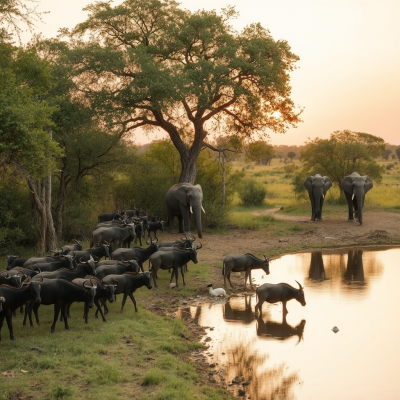Natural Landmarks: Serengeti Reserve (Kenya and Tanzania)

WIldbeests and elephants converge at a watering hole in the cool of the day at the Serengeti (Imagined by AI)
The Serengeti: Africa’s Timeless Wilderness and the Great Migration
Stretching across northern Tanzania and into southwestern Kenya, the Serengeti is a vast expanse of savannah teeming with life. Covering approximately 30,000 square kilometers, this region is renowned for its breathtaking landscapes, diverse wildlife, and the world-famous Great Migration.
A Landscape Where the Land Runs Forever
The name “Serengeti” originates from the Maasai word Siringet, meaning “the place where the land runs on forever.” This description aptly captures the endless plains that define the region. From rolling grasslands to riverine forests and acacia woodlands, the Serengeti’s varied habitats support an incredible array of flora and fauna.(
The Great Migration: Nature’s Grand Spectacle
Each year, over 1.5 million wildebeest, accompanied by 250,000 zebras and hundreds of thousands of gazelles, embark on a perilous journey in search of fresh grazing grounds. This cyclical migration spans approximately 800 kilometers, making it the largest terrestrial mammal migration on Earth.
The journey begins in the southern Serengeti, where, between January and March, the plains are lush from seasonal rains. This period marks the calving season, with around 500,000 wildebeest calves born within a few weeks. As the rains cease in May, the herds move northwest towards the Grumeti River, facing challenges like crocodile-infested waters. By July and August, they reach the Mara River, another treacherous crossing point, before entering Kenya’s Maasai Mara. With the onset of short rains in November, the herds journey back south, completing the cycle.
A Biodiversity Hotspot
Beyond the migrating herds, the Serengeti boasts an impressive diversity of wildlife. It’s home to Africa’s iconic Big Five: lions, leopards, elephants, buffaloes, and rhinoceroses. The park supports over 70 large mammal species and more than 500 bird species, making it a haven for wildlife enthusiasts and birdwatchers alike.
Predators like cheetahs, hyenas, and crocodiles play crucial roles in maintaining the ecological balance. Smaller creatures, from dung beetles to various reptiles, contribute to the park’s rich tapestry of life.
The Maasai: Guardians of the Plains
The Maasai people have coexisted with the Serengeti’s wildlife for centuries. Their semi-nomadic lifestyle and deep respect for nature have allowed them to live in harmony with the environment. However, historical events, including the establishment of protected areas, have led to challenges and relocations for the Maasai communities.
Conservation Efforts and Challenges
Recognized as a UNESCO World Heritage Site, the Serengeti faces threats from poaching, habitat loss, and climate change. Conservation initiatives focus on preserving the ecosystem, supporting local communities, and promoting sustainable tourism. Collaborative efforts between governments, NGOs, and indigenous groups aim to ensure the Serengeti remains a sanctuary for future generations.
Visiting the Serengeti
The Serengeti offers unparalleled safari experiences. Visitors can witness the Great Migration, explore diverse habitats, and immerse themselves in the region’s natural beauty. With various accommodation options, from luxury lodges to mobile camps, travelers can tailor their adventures to their preferences.
The Serengeti stands as a testament to nature’s grandeur and resilience. Its vast landscapes, rich biodiversity, and the awe-inspiring Great Migration make it one of the world’s most cherished natural wonders. By supporting conservation efforts and responsible tourism, we can help preserve this magnificent ecosystem for generations to come.
Learn about more Natural Landmarks
